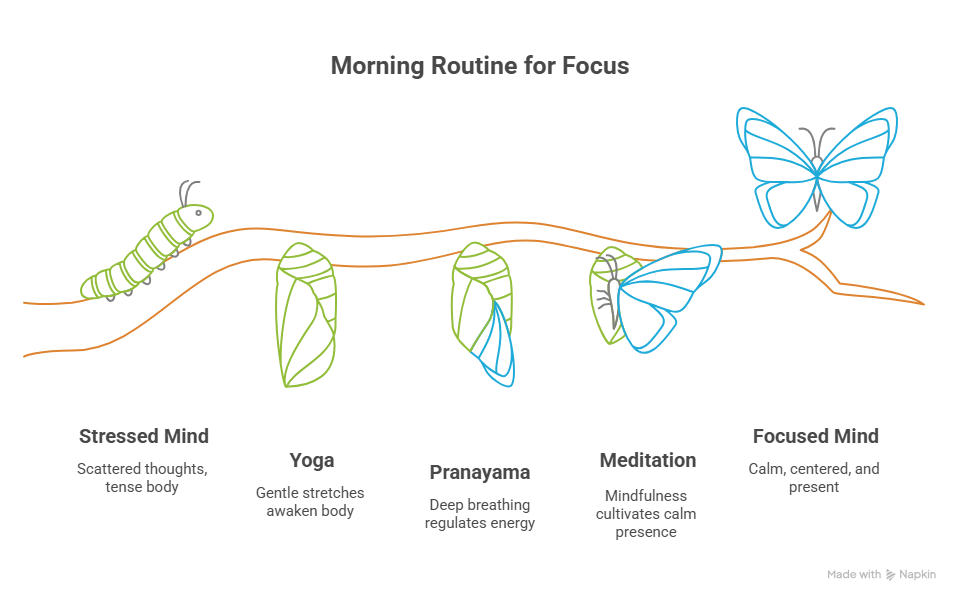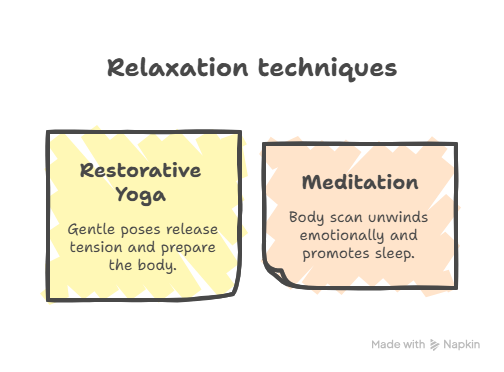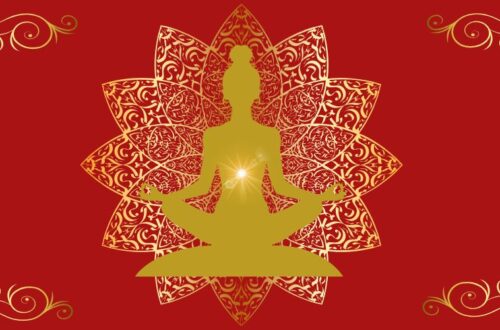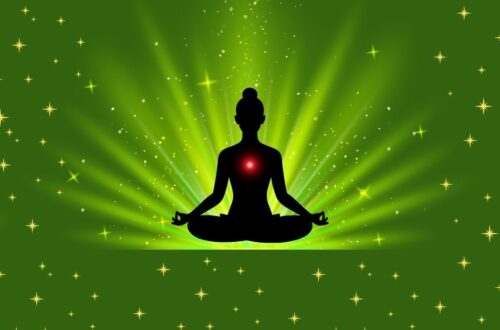Yoga and Meditation: Enhance Inner Peace and Focus
Against the backdrop of today’s dynamic and fast-paced environment, achieving mental clarity can often feel like an elusive goal. The constant influx of information and daily responsibilities can cloud our minds, leading to stress, distraction, and diminished productivity. Fortunately, ancient practices such as yoga and meditation for mental clarity offer a holistic approach to rejuvenating the mind and body, fostering sharper focus and deeper inner peace.
The yoga path focused on meditation creates a powerful synergy. Yoga prepares the body and mind through mindful movement and controlled breathing, while meditation cultivates stillness and heightened awareness. Together, they form a comprehensive mindful routine that enhances clarity of thoughts, promotes emotional awareness, and supports overall well-being.
Understanding Mental Clarity
Mental clarity is the state of having focused attention, free from mental stress and distractions. It allows for improved decision-making, enhanced memory, and increased creativity. Achieving this clarity requires cultivating attention to the present moment and developing a calm, centered mind.
Practices that nurture mindfulness and self-reflection play a pivotal role in achieving mental clarity. Both yoga and meditation emphasize these qualities, making them ideal tools for anyone seeking to sharpen their mental faculties and maintain emotional balance.
The Role of Yoga in Enhancing Mental Clarity
Yoga transcends mere physical exercise; it is a profound relaxation practice that harmonizes the mind and body. Here’s how yoga contributes to mental clarity:
1. Mindful Movement
Each yoga posture encourages practitioners to engage in attention to the present by focusing on bodily sensations and alignment. This mindful engagement reduces mental distractions and fosters concentration, helping the mind settle into a state of calm focus.
2. Breath Control (Pranayama)
Breathing techniques such as Nadi Shodhana (alternate nostril breathing) or deep belly breathing balance the autonomic nervous system. These practices calm the mind, reduce anxiety, and enhance oxygen flow, which collectively improve cognitive function and mental clarity.
3. Stress Reduction
Yoga activates the parasympathetic nervous system, reducing stress hormones like cortisol. Lower stress levels contribute to clearer thinking and improved emotional awareness, enabling you to respond thoughtfully rather than react impulsively
Meditation helps to Cultivate Inner Stillness
Meditation complements yoga by training the mind to maintain focused awareness and deepen self-awareness. Different meditation styles offer unique pathways to mental clarity:
1. Mindfulness Meditation
This practice involves observing thoughts and bodily sensations non-judgmentally, cultivating a state of non-reactive awareness. Such consistent mindfulness practice helps clear mental clutter and enhances self-awareness.
2. Focused Attention Meditation
By concentrating on a single object—be it the breath, a mantra, or a candle flame—this technique trains the mind to sustain attention and reduce mental chatter, sharpening clarity of thoughts.
3. Vipassana Meditation
An insight meditation that involves observing the impermanent nature of sensations and thoughts, Vipassana fosters profound emotional balance and mental purification.
A daily routine build the synergy between yoga and meditation
Creating a structured daily routine that combines yoga and meditation can significantly boost your mental clarity and emotional balance. Here’s a simple yet effective plan:
Morning Routine

- Yoga Practice (15 minutes): Begin your day with gentle stretches and sun salutations to awaken the body and mind. This mindful movement primes your nervous system for focus.
- Pranayama (5 minutes): Practice deep belly breathing or Nadi Shodhana to center your mind and regulate energy flow.
- Meditation (10 minutes): Engage in mindfulness meditation to cultivate presence and set a calm, focused tone for the day ahead.
Evening Routine

- Restorative Yoga (10 minutes): Gentle poses such as Child’s Pose (Balasana) help release accumulated tension and prepare your body for rest.
- Meditation (10 minutes): Practice a body scan or loving-kindness meditation to unwind emotionally and promote restful sleep.
Guide for Maintaining Consistency in Your Practice
Maintaining motivation and consistency is key to experiencing the full benefits of yoga and meditation. Here are some practical tips:
Create a Dedicated, Uncluttered Environment
Designate a quiet, tidy space in your home for practice. An uncluttered environment minimizes distractions and signals your brain that it’s time to focus and relax.
Set Realistic Goals
Start with short sessions and gradually increase duration as your comfort and concentration improve. This approach aligns with how to start mindfulness meditation for beginners and prevents burnout.
Use Guided Resources
Leverage apps like Calm or Insight Timer, which offer guided mindfulness meditation at home and yoga sessions tailored to various skill levels and goals. These resources provide structure and encouragement.
Be Patient and Compassionate
Progress may be subtle and gradual. Embrace the journey with kindness toward yourself, recognizing that lapses and distractions are natural parts of the process.
Incorporating yoga and meditation for mental clarity into your daily life is a transformative journey toward enhanced focus, emotional balance, and inner peace. By dedicating time to these practices within a mindful routine, you cultivate a resilient mind capable of navigating life’s complexities with grace and composure.
Remember, the goal is not perfection but presence—being fully engaged with the moment. Through consistent mindfulness practice, supported by thoughtful movement and breathwork, you can unlock a clearer, calmer, and more vibrant mind.






